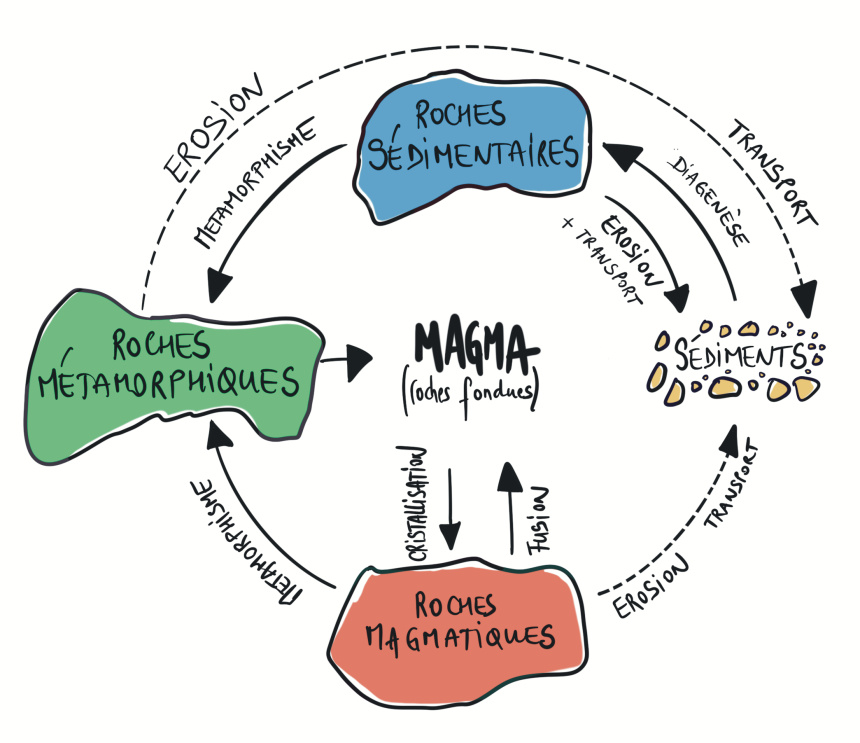Rocks form in different ways. Geologists distinguish three families: igneous rocks, sedimentary rocks, and metamorphic rocks.
Igneous Rocks
These rocks come from the crystallization of magma. There are three cases: plutonic, hypabyssal (or dike), and volcanic rocks. The cooling rate of the magma defines the size of the minerals in the resulting rock. The slower the cooling, the larger the crystals (geologists call this a coarse-grained texture). The faster the cooling, the smaller the crystals (called a fine-grained or microcrystalline texture).
Plutonic rocks form from the slow cooling of magma deep underground. These magmas form in different contexts. Gabbros make up the lower part of the oceanic crust. Granites, and more broadly granitoids, form in the heart of the continental crust in subduction or collision zones (mountain-building). Both granites and gabbros have a coarse-grained texture. Gabbros reveal the existence of an ancient oceanic domain, while Breton granites testify to two orogenies (oro- means mountain in Greek): the Cadomian orogeny (650 Ma* - 540 Ma*) and the Hercynian orogeny (360 Ma - 300 Ma).
*Ma: million years ago
Hypabyssal (dike) rocks form on the edges of plutons or near the surface, beneath volcanic structures. These small, narrow magma bodies cool relatively quickly, producing a fine-grained texture.
Volcanic rocks are surface igneous rocks that form volcanoes. Their nature varies depending on the magma composition, temperature, and where it erupts. In Brittany, old underwater lava flows (basaltic pillow lavas) and volcanic ash deposits from explosive eruptions are exposed. Brittany was volcanically active at different times.
Sedimentary Rocks
These rocks form in natural basins: plains, lakes, oceans. They result from the accumulation of sediments of various sizes: pebbles, sands, silts, clayey or carbonate muds, and fragments of organisms. Some of these materials come from erosion of reliefs. Sediments pile up in horizontal layers and gradually become coherent sedimentary rocks through processes called diagenesis. A common feature of these rocks is that they can contain fossils, which provide information about their depositional environment. These rocks are easy to recognize in the field due to their layered structure (also called strata).
Metamorphic Rocks
When existing rocks (igneous, sedimentary, or even metamorphic) are subjected to different physical conditions (increased temperature and/or pressure), their minerals and textures transform. Geologists call this metamorphism: “change of form.” Some minerals disappear, others form because they are more stable under the new conditions. Minerals realign according to the direction of applied forces. All these changes occur in the solid state.
The Rock Cycle
The rocks making up the Earth’s crust (lithosphere) continuously evolve due to the dynamics of lithospheric plates (plate tectonics) and the presence of an atmosphere at the surface that promotes natural weathering.
